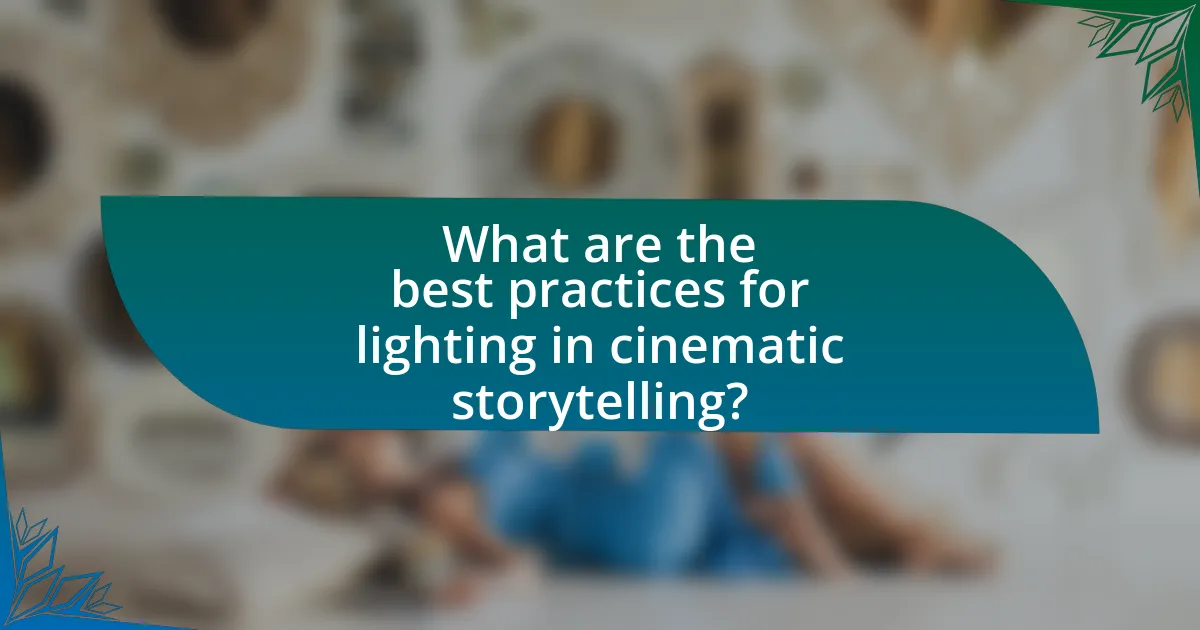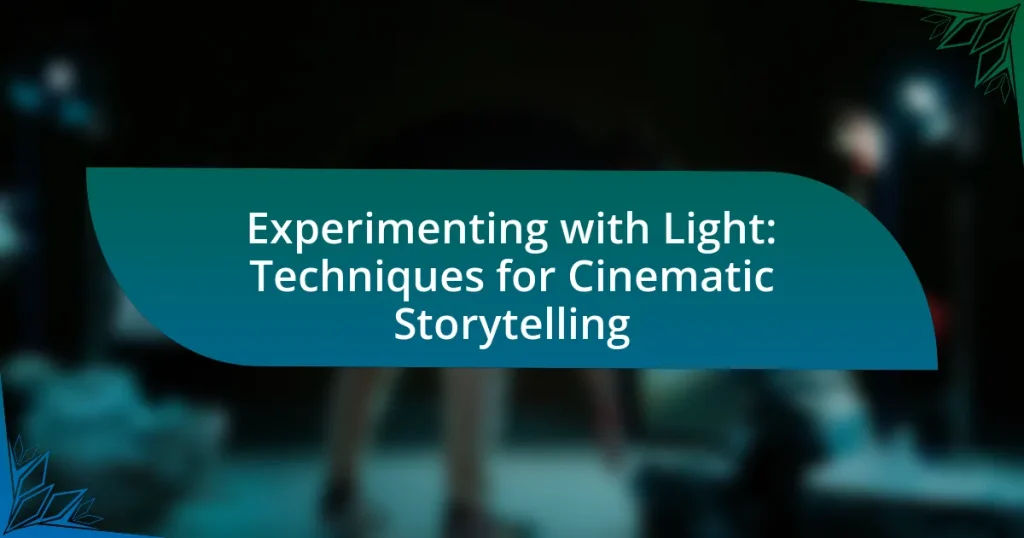The article “Experimenting with Light: Techniques for Cinematic Storytelling” explores the fundamental principles of light in film, including direction, quality, color, and intensity, and their impact on mood and atmosphere. It discusses various lighting types, such as key, fill, and backlighting, and emphasizes the significance of color temperature in shaping emotional tones. Additionally, the article addresses the role of natural light, innovative lighting techniques, and best practices for effective lighting design, while also highlighting common challenges and mistakes filmmakers may encounter. Overall, it provides a comprehensive overview of how lighting can enhance storytelling and character development in cinema.

What are the fundamental principles of light in cinematic storytelling?
The fundamental principles of light in cinematic storytelling include direction, quality, color, and intensity. Direction refers to the angle from which light hits the subject, influencing mood and depth; for example, side lighting can create shadows that add drama. Quality pertains to the softness or hardness of light, with soft light producing flattering images and hard light creating stark contrasts. Color affects the emotional tone of a scene; warm colors can evoke feelings of comfort, while cool colors may suggest tension or unease. Intensity determines the brightness of the light, which can highlight key elements or create a sense of mystery through darkness. These principles are essential for shaping the visual narrative and guiding audience perception in film.
How does light influence mood and atmosphere in film?
Light significantly influences mood and atmosphere in film by shaping the visual tone and emotional response of the audience. For instance, high-key lighting creates a bright, cheerful atmosphere, often used in comedies, while low-key lighting generates shadows and contrast, evoking tension or suspense in thrillers and horror films. Research by the American Psychological Association indicates that lighting can affect emotional perception; bright light is associated with happiness, while dim light can lead to feelings of sadness or anxiety. This demonstrates that filmmakers strategically manipulate light to enhance storytelling and guide audience emotions effectively.
What are the different types of lighting used in cinematography?
The different types of lighting used in cinematography include key lighting, fill lighting, backlighting, and practical lighting. Key lighting serves as the primary source of illumination, defining the subject’s features and creating depth. Fill lighting complements key lighting by softening shadows and reducing contrast, ensuring details are visible. Backlighting creates a silhouette effect, enhancing the subject’s outline and adding dimension. Practical lighting refers to light sources that are visible within the scene, such as lamps or candles, contributing to the overall ambiance and realism. Each type plays a crucial role in shaping the visual narrative and emotional tone of a film.
How can color temperature affect the emotional tone of a scene?
Color temperature significantly influences the emotional tone of a scene by altering the viewer’s perception and mood. Warm color temperatures, typically ranging from 2700K to 3500K, evoke feelings of comfort, intimacy, and happiness, often used in scenes depicting romance or nostalgia. In contrast, cool color temperatures, ranging from 5000K to 6500K, can create a sense of detachment, sadness, or tension, frequently employed in dramatic or suspenseful moments. Research indicates that color temperature can affect physiological responses, such as heart rate and emotional arousal, reinforcing its impact on storytelling in visual media.
What role does natural light play in filmmaking?
Natural light plays a crucial role in filmmaking by providing authentic illumination that enhances the visual storytelling. It creates a natural atmosphere, contributing to the mood and tone of a scene, which can evoke genuine emotions from the audience. For instance, filmmakers often utilize the golden hour, the period shortly after sunrise or before sunset, to capture soft, warm light that adds depth and richness to the visuals. This technique is widely recognized for its ability to create visually stunning imagery, as seen in films like “The Tree of Life,” where natural light significantly contributes to the film’s aesthetic and emotional impact.
How can filmmakers effectively utilize natural light sources?
Filmmakers can effectively utilize natural light sources by planning shoots during the golden hour, which occurs shortly after sunrise and before sunset, providing soft, diffused lighting that enhances visual aesthetics. This technique is supported by the fact that natural light during these times creates a warm color palette and reduces harsh shadows, making it ideal for capturing emotional scenes. Additionally, filmmakers can use reflectors to bounce natural light onto subjects, thereby controlling the intensity and direction of the light, which further improves the overall quality of the footage.
What challenges do filmmakers face when working with natural light?
Filmmakers face several challenges when working with natural light, primarily due to its unpredictability and variability. Natural light changes throughout the day, affecting the quality, intensity, and color temperature, which can lead to inconsistent lighting conditions during a shoot. For instance, the golden hour provides soft, warm light, but this lasts only a short time, requiring filmmakers to plan meticulously to capture the desired effect. Additionally, filmmakers must contend with weather conditions, such as clouds or rain, which can alter lighting dramatically and unexpectedly. These factors necessitate quick adjustments in camera settings and shooting schedules, complicating the production process.

How can filmmakers experiment with light to enhance storytelling?
Filmmakers can experiment with light to enhance storytelling by manipulating its intensity, color, and direction to evoke specific emotions and highlight narrative elements. For instance, using low-key lighting creates shadows that can convey tension or mystery, while high-key lighting can produce a bright, cheerful atmosphere. Additionally, colored gels can alter the mood; warm tones often evoke comfort, while cool tones can suggest sadness or detachment. The direction of light also plays a crucial role; backlighting can create silhouettes that add drama, while frontal lighting can emphasize facial expressions, making characters’ emotions more relatable. These techniques are supported by studies in film theory, such as those by David Bordwell and Kristin Thompson, which illustrate how lighting choices directly influence audience perception and emotional engagement in cinematic narratives.
What are some innovative lighting techniques used in modern cinema?
Innovative lighting techniques used in modern cinema include LED lighting, practical lighting integration, and dynamic lighting systems. LED lighting has revolutionized film production by providing energy efficiency, versatility, and the ability to change color temperatures on set, allowing for greater creative control. Practical lighting integration involves using real-world light sources within a scene, enhancing realism and immersion. Dynamic lighting systems, such as those utilizing programmable lights, enable filmmakers to create complex lighting effects that can change in response to the narrative, enhancing emotional impact. These techniques reflect advancements in technology and a shift towards more immersive storytelling in cinema.
How can practical effects be combined with lighting for dramatic impact?
Practical effects can be combined with lighting to create dramatic impact by enhancing the visual storytelling through the interplay of shadows, highlights, and textures. For instance, using low-key lighting can accentuate the physicality of practical effects, such as smoke or explosions, by casting deep shadows that add depth and tension to a scene. This technique is supported by the fact that filmmakers like Ridley Scott have effectively utilized chiaroscuro lighting to amplify the emotional weight of practical effects in films like “Blade Runner.” By strategically positioning lights to interact with practical effects, filmmakers can manipulate audience perception and evoke specific emotional responses, thereby reinforcing the narrative.
What is the significance of shadows in visual storytelling?
Shadows play a crucial role in visual storytelling by enhancing depth, creating mood, and guiding viewer attention. They contribute to the three-dimensionality of a scene, making characters and environments more dynamic and engaging. For instance, shadows can evoke emotions such as fear or suspense, as seen in film noir, where stark contrasts between light and shadow heighten tension. Additionally, shadows can symbolize themes or character traits; for example, a character cast in shadow may represent inner conflict or moral ambiguity. This use of shadows is supported by studies in cinematography, which demonstrate that effective lighting and shadow techniques can significantly impact audience perception and emotional response.
How can lighting design contribute to character development?
Lighting design significantly contributes to character development by visually conveying emotions, intentions, and transformations of characters. For instance, high-key lighting can create a sense of openness and positivity, often associated with heroic or likable characters, while low-key lighting can evoke mystery or danger, aligning with antagonistic or complex characters. This technique is supported by studies in film theory, such as those by David Bordwell and Kristin Thompson, which highlight how lighting shapes audience perception and emotional response. By manipulating light intensity, color, and direction, filmmakers can enhance narrative depth and character arcs, making lighting a crucial element in storytelling.
What lighting choices can signify a character’s emotional state?
Lighting choices such as high contrast, soft lighting, and color temperature can significantly signify a character’s emotional state. High contrast lighting, characterized by stark shadows and bright highlights, often conveys tension or conflict, reflecting a character’s inner turmoil. Soft lighting, which diffuses shadows and creates a gentle ambiance, typically signifies warmth, comfort, or vulnerability, indicating a character’s openness or affection. Additionally, the use of color temperature plays a crucial role; warm colors like reds and yellows can evoke feelings of passion or anger, while cool colors such as blues and greens often suggest sadness or calmness. These lighting techniques are widely recognized in cinematography, as they directly influence audience perception of a character’s emotions.
How does lighting help in establishing relationships between characters?
Lighting plays a crucial role in establishing relationships between characters by visually conveying emotional dynamics and interactions. For instance, high-key lighting can create a sense of warmth and intimacy, suggesting a positive relationship, while low-key lighting can evoke tension or conflict, indicating a strained relationship. Studies in film theory, such as those by Bordwell and Thompson in “Film Art: An Introduction,” highlight how lighting choices directly influence audience perception of character relationships, reinforcing the narrative through visual cues.

What are the best practices for lighting in cinematic storytelling?
The best practices for lighting in cinematic storytelling include using three-point lighting, understanding color temperature, and creating mood through shadows. Three-point lighting, which consists of key, fill, and back lights, provides depth and dimension to subjects, enhancing visual storytelling. Understanding color temperature is crucial, as it affects the emotional tone of a scene; for instance, warmer tones can evoke comfort, while cooler tones can create tension. Additionally, manipulating shadows can add drama and focus, guiding the audience’s attention to specific elements within the frame. These practices are supported by industry standards, such as those outlined in “The Filmmaker’s Eye” by Gustavo Mercado, which emphasizes the importance of lighting in conveying narrative and emotion.
How can filmmakers create a lighting plan for their projects?
Filmmakers can create a lighting plan for their projects by first determining the mood and atmosphere they want to convey, which directly influences the choice of lighting techniques and equipment. This involves analyzing the script, identifying key scenes, and deciding on the emotional tone, such as whether it should be bright and cheerful or dark and moody.
Next, filmmakers should select the appropriate lighting sources, such as key lights, fill lights, and backlights, to achieve the desired effect. For instance, using soft light can create a flattering look, while hard light can produce dramatic shadows.
Additionally, filmmakers must consider the placement and angle of lights to enhance depth and dimension in the frame. For example, lighting from below can create an unsettling effect, while lighting from above can mimic natural sunlight.
Finally, testing different lighting setups during rehearsals allows filmmakers to refine their plan and make adjustments based on how the light interacts with the actors and set. This iterative process ensures that the final lighting plan effectively supports the storytelling.
What tools and equipment are essential for effective lighting design?
Essential tools and equipment for effective lighting design include light fixtures, light meters, gels, diffusion materials, and control systems. Light fixtures, such as LED panels, spotlights, and softboxes, provide the necessary illumination and can be adjusted for intensity and color temperature. Light meters are crucial for measuring light levels and ensuring proper exposure, while gels and diffusion materials help modify the quality and color of light to achieve desired effects. Control systems, including dimmers and smart lighting software, allow for precise adjustments and automation in lighting setups. These tools collectively enhance the ability to create mood, depth, and visual storytelling in cinematic projects.
How can filmmakers troubleshoot common lighting issues on set?
Filmmakers can troubleshoot common lighting issues on set by assessing the light source, adjusting the placement of lights, and utilizing diffusion materials. For instance, if shadows are too harsh, repositioning the light or adding a softbox can create a more even illumination. Additionally, if the color temperature is inconsistent, filmmakers can use gels to match the light sources or adjust the camera settings to compensate. These methods are effective as they directly address specific lighting challenges, ensuring optimal visual quality in the final product.
What tips can enhance the effectiveness of lighting in storytelling?
To enhance the effectiveness of lighting in storytelling, utilize three key techniques: control the direction of light, manipulate color temperature, and create contrast. Controlling the direction of light shapes the mood and highlights important elements, as seen in classic films where low-angle lighting creates tension. Manipulating color temperature can evoke specific emotions; for instance, warm tones often convey comfort, while cool tones suggest unease. Creating contrast between light and shadow adds depth and visual interest, as demonstrated in noir films where stark lighting emphasizes character dilemmas. These techniques collectively improve narrative engagement and visual storytelling.
How can filmmakers balance artistic vision with practical lighting constraints?
Filmmakers can balance artistic vision with practical lighting constraints by employing adaptive lighting techniques that enhance the narrative while accommodating available resources. For instance, using natural light creatively can maintain the desired aesthetic without extensive equipment, as demonstrated in films like “The Revenant,” where natural lighting was pivotal to the film’s immersive experience. Additionally, filmmakers can utilize portable lighting equipment and modifiers to achieve specific looks while remaining flexible in various shooting environments. This approach allows for the integration of artistic intent with the realities of production logistics, ensuring that the visual storytelling remains compelling despite limitations.
What are the common mistakes to avoid when experimenting with light?
Common mistakes to avoid when experimenting with light include improper placement of light sources, neglecting the quality of light, and failing to consider the color temperature. Improper placement can lead to unflattering shadows or uneven lighting, which detracts from the visual narrative. Neglecting the quality of light, such as using harsh light instead of soft light, can create undesirable effects on skin tones and textures. Additionally, failing to consider color temperature can result in mismatched lighting that disrupts the mood and coherence of the scene. These mistakes can significantly impact the effectiveness of cinematic storytelling by compromising the visual aesthetics and emotional resonance of the footage.


